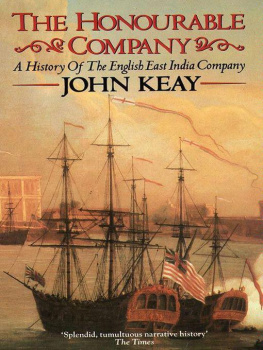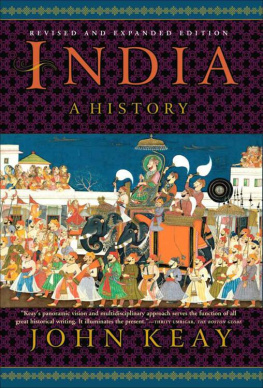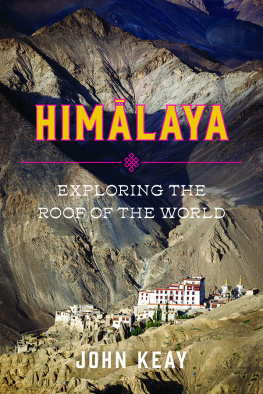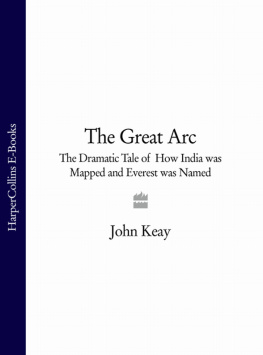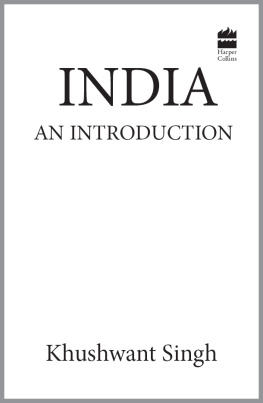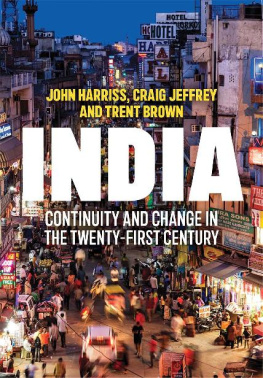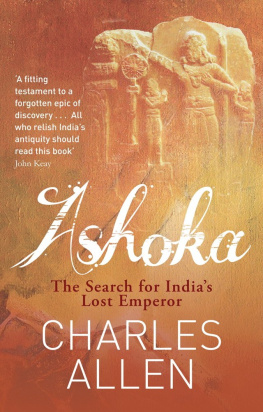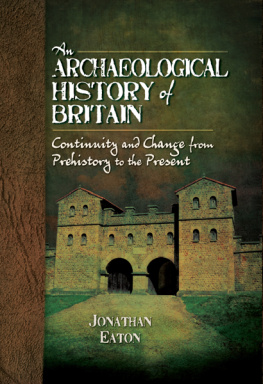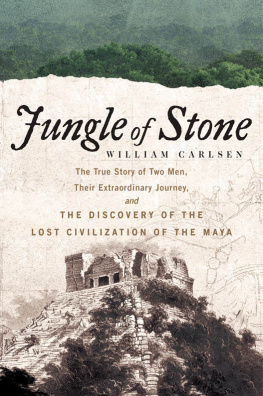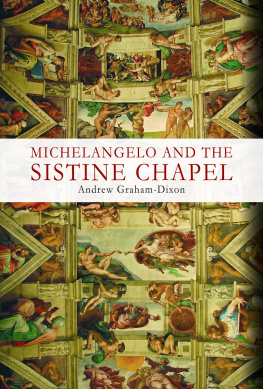INDIA
DISCOVERED

The Recovery of a Lost
Civilization
J OHN KEAY

Contents
CHAPTER ONE
This Wonderful Country
CHAPTER TWO
An Inquisitive Englishman
CHAPTER THREE
Thus Spake Ashoka
CHAPTER FOUR
Black and Time-Stained Rocks
CHAPTER FIVE
The Legacy of Pout
CHAPTER SIX
The Old Campaigner
CHAPTER SEVEN
Buddha in a Toga
CHAPTER EIGHT
A Little Warmer than Necessary
CHAPTER NINE
Wild in Human Faith and Warm in Human Feeling
CHAPTER TEN
A Subject of Frequent Remark
CHAPTER ELEVEN
Hiding Behind the Elgin Marbles
CHAPTER TWELVE
Some Primitive Vigour
CHAPTER THIRTEEN
New Observations and Discoveries
CHAPTER FOURTEEN
An Idolatrous Affection
CHAPTER FIFTEEN
The Stupendous Fabric of Nature

1. Aurangzebs mosque above Panchganga.
2. James Prinsep with Hindu pandits, Sanskrit College, Benares.
3. The rock of Girnar.
4. The temples of Mahabalipuram.
5. Cave temples of western India.
6. The stupas of Sanchi.
7. The ruined temple of Boddh Gaya.
8. A Buddhist stupa railing at Mathura.
9. The Buddha.
10. A Boddhisattva.
11. The temple complex of Khajuraho.
12. Carving at Khajuraho.
13. The festival of Jagannath at Puri.
14. Colin Mackenzie at work.
15. Bishop Hebers drawing of Amber palace.
16. Gwalior, the Gibraltar of India.
17. The Qutb mosque.
18. Shah Jehans Jama Masjid.
19. The tomb of Humayun in Delhi.
20. The Taj Mahal in Agra.
21. The Sanchi torso.
22. The wall paintings in the caves of Ajanta.
23. A scene depicting The Temptation in Ajanta Cave.
24. Colonel James Tod. 25. Colonel Colin Mackenzie. 26. E. B. Havell. 27. Sir William Jones. 28. Lord Curzon. 29. B. H. Hodgson. 30. General Sir Alexander Cunningham. 31. Sir George Everest by William Tayler.
32. Mohenjo-daro Giri.
33. Seals from the Indus Valley civilization.
The author and publisher are grateful to the following for their kind permission to reproduce the above illustrations: the India Office Library, British Museum for nos. 15, 7, 11, 1316, 19, 22, 2530; the Victoria & Albert Museum for nos. 6, 9, 17, 18, 23 and 24; the British Museum for nos. 10 and 33; the Werner Forman Archive, London for no. 12; the British Architectural Library, RIBA for no. 20; the National Portrait Gallery no. 31; and the National Museum, New Delhi for no. 32. Illustration no. 8 is reproduced from Archaeological Survey of India, Report of a Tour in the Central Provinces Lower Gangetic Doab 188081 by Alexander Cunningham, Vol. XVII, Plate xxi.
Some day the whole story of British Indology will
be told and that will assuredly make a glorious,
fascinating and inspiring narrative.
A. J. Arberry, British Orientalists (1943)
Two hundred years ago India was the land of the fabulous and fantastic, the Exotic East. Travellers returned with tales of marble palaces with gilded domes, of kings who weighed themselves in gold, and of dusky maidens dripping with pearls and rubies. Before this sumptuous backdrop passed elephants, tigers and unicorns, snake charmers and sword swallowers, pedlars of reincarnation and magic, long-haired ascetics on beds of nails, widows leaping into the pyre. It was like some glorious and glittering circus spectacular, exciting, but a little unreal.
Now, in place of the circus, we have the museum. India is a supreme cultural experience. Instead of the rough and tumble of the big top, we have meditation and the subtle notes of the sitar. It is temples and tombs, erotic sculpture, forlorn palaces and miniature masterpieces. Hinduism is studied in deadly earnest; the ascetic no longer needs a bed of nails to ensure an audience. Even the elephants and tigers have become too important to be fun; they too must be carefully studied and preserved.
This dramatic change in attitude was principally brought about by a painstaking investigation of all things Indian. No subject people, no conquered land, was ever as exhaustively studied as was India during the period of British rule. It is this aspect of the British affair in India which forms the subject of this book.
The nineteenth century was the age of enquiry. It was perhaps inevitable that India should have its Darwin, its Livingstone and its Schliemann. There was also something in the paternalistic nature of British imperialism that attracted the scholar and the scientist. The men who discovered India came as amateurs; by profession they were soldiers and administrators. But they returned home as giants of scholarship.
And then, above all, there was India itself, exercising its own irresistible fascination. The more it was probed the greater became its antiquity, the more inexhaustible its variety, and the more inconceivable its subtleties. The pioneers of Indian studies, described in this book, rose to the challenge. Man and Nature; whatever is performed by the one or produced by the other would be the field of their enquiries.
The results, even in an age of discoveries, were as sensational as the country and the scope of the undertaking. For a start, Indian history was pushed back two thousand years, roughly from the age of William the Conqueror to a millennium or so before that of Tutankhamun. In the process two great classical civilizations were discovered, and one of the richest literary traditions was revealed to the outside world. So were the origins of two of the worlds major religions. What Lord Curzon called the greatest galaxy of monuments in the world was rescued from decay, classified and conserved. Ancient scripts were deciphered, dated and used to disentangle the history of kings and emperors. Coins and paintings by the hundred were discovered, and their significance charted. Western sensibilities struggled to come to terms with the discovery of erotic sculptures in places of worship. In the natural sciences one of the most exciting flora and fauna was studied and catalogued; so too was the incredibly rich human miscellany of racial, linguistic and religious groups. The entire sub-continent was surveyed and mapped; in the process the worlds highest mountains were measured. And so on. In short the modern image of India was pieced together.
In tracing this process, I have tried to convey something of the wonder of each new discovery and the excitement of each new deduction. The men who stumbled upon sites like the temple complex of Khajuraho or the painted caves of Ajanta, felt as if they had suddenly come upon the Uffizi swathed in creepers, swarming with bats and unvisited for a thousand years. It is not hard to understand their astonishment. Parts of India are still littered with monuments and ruins that have never attracted the attention of conservationists. Herdsmen bivouac in royal palaces, mirror-work mosaics crunch underfoot, and bees nests hang from painted ceilings. It is one of Indias perhaps ironic glories that, in addition to the more popular and spectacular sites, she still has real ruins, untended, still crumbling, still succumbing to the rains and the vegetation.
The discovery of these varied and magnificent monuments stimulated curiosity about Indias past. It is hard to appreciate now that as late as the end of the eighteenth century nothing whatsoever was known of Indian history prior to the Mohammedan invasions. It is at this epoch [AD 1000], wrote Thomas Twining in 1790, that we come to a line of shade beyond which no object is distinctly discernible. What treasures might not be discovered if the light of science should ever penetrate this darkness. To Twining, Indian history was like some deep Aladdins cave. The outer chambers were well lit thanks to recent Mohammedan chroniclers, but beyond them the cave was in darkness. How far back it went no one could tell. There was just one uncertain clue the invasion of Alexander the Great in 326 BC. By exploring every possible source, and by combining guesswork with some brilliant deduction, the orientalists successfully penetrated this darkness. The excitement when, deep in the gloom, some new light was shed, was tremendous. But much remained in the gloom; whole centuries defied illumination.
Next page

